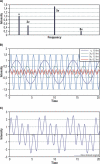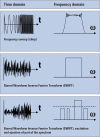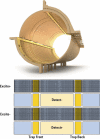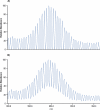Fourier transform mass spectrometry
- PMID: 21742802
- PMCID: PMC3134075
- DOI: 10.1074/mcp.M111.009431
Fourier transform mass spectrometry
Abstract
This article provides an introduction to Fourier transform-based mass spectrometry. The key performance characteristics of Fourier transform-based mass spectrometry, mass accuracy and resolution, are presented in the view of how they impact the interpretation of measurements in proteomic applications. The theory and principles of operation of two types of mass analyzer, Fourier transform ion cyclotron resonance and Orbitrap, are described. Major benefits as well as limitations of Fourier transform-based mass spectrometry technology are discussed in the context of practical sample analysis, and illustrated with examples included as figures in this text and in the accompanying slide set. Comparisons highlighting the performance differences between the two mass analyzers are made where deemed useful in assisting the user with choosing the most appropriate technology for an application. Recent developments of these high-performing mass spectrometers are mentioned to provide a future outlook.
Figures



















Similar articles
-
Recent instrumental progress in mass spectrometry: advancing resolution, accuracy, and speed of drug detection.Drug Test Anal. 2012 Mar-Apr;4(3-4):242-5. doi: 10.1002/dta.344. Epub 2012 Feb 28. Drug Test Anal. 2012. PMID: 22374710
-
Tandem mass spectrometry in quadrupole ion trap and ion cyclotron resonance mass spectrometers.Methods Enzymol. 2005;402:109-48. doi: 10.1016/S0076-6879(05)02004-5. Methods Enzymol. 2005. PMID: 16401508 Review.
-
Electrospray ionization Fourier transform ion cyclotron resonance mass spectrometry.Annu Rev Phys Chem. 1999;50:517-36. doi: 10.1146/annurev.physchem.50.1.517. Annu Rev Phys Chem. 1999. PMID: 10575730 Review.
-
Obtaining more accurate Fourier transform ion cyclotron resonance mass measurements without internal standards using multiply charged ions.J Am Soc Mass Spectrom. 2000 May;11(5):416-21. doi: 10.1016/S1044-0305(00)00096-9. J Am Soc Mass Spectrom. 2000. PMID: 10790845
-
An automated high performance capillary liquid chromatography-Fourier transform ion cyclotron resonance mass spectrometer for high-throughput proteomics.J Am Soc Mass Spectrom. 2004 Feb;15(2):212-32. doi: 10.1016/j.jasms.2003.09.008. J Am Soc Mass Spectrom. 2004. PMID: 14766289
Cited by
-
Accelerating Fourier Transform-Ion Cyclotron Resonance Mass Spectrometry Imaging Using a Subspace Approach.J Am Soc Mass Spectrom. 2020 Nov 4;31(11):2338-2347. doi: 10.1021/jasms.0c00276. Epub 2020 Oct 16. J Am Soc Mass Spectrom. 2020. PMID: 33064944 Free PMC article.
-
The emerging role of native mass spectrometry in characterizing the structure and dynamics of macromolecular complexes.Protein Sci. 2015 Aug;24(8):1176-92. doi: 10.1002/pro.2661. Epub 2015 Mar 31. Protein Sci. 2015. PMID: 25676284 Free PMC article. Review.
-
Advances in Ultra-High-Resolution Mass Spectrometry for Pharmaceutical Analysis.Molecules. 2023 Feb 22;28(5):2061. doi: 10.3390/molecules28052061. Molecules. 2023. PMID: 36903305 Free PMC article. Review.
-
Native vs Denatured: An in Depth Investigation of Charge State and Isotope Distributions.J Am Soc Mass Spectrom. 2020 Mar 4;31(3):574-581. doi: 10.1021/jasms.9b00040. Epub 2020 Feb 4. J Am Soc Mass Spectrom. 2020. PMID: 31971796 Free PMC article.
-
External Data Systems Enable Enhanced (and Sustainable) Fourier Transform Mass Spectrometry Imaging for Legacy Hybrid Linear Ion Trap-Orbitrap Platforms.J Am Soc Mass Spectrom. 2024 Nov 6;35(11):2690-2698. doi: 10.1021/jasms.4c00145. Epub 2024 Jul 20. J Am Soc Mass Spectrom. 2024. PMID: 39031087 Free PMC article.
References
-
- Zhu M., Ma L., Zhang H., Humphreys W. G. (2007) Detection and structural characterization of glutathione-trapped reactive metabolites using liquid chromatography-high-resolution mass spectrometry and mass defect filtering. Anal. Chem. 79, 8333–8341 - PubMed
-
- Cox J., Mann M. (2009) Computational principles of determining and improving mass precision and accuracy for proteome measurements in an orbitrap. J. Am. Soc. Mass Spectrom. 20, 1477–1485 - PubMed
Publication types
MeSH terms
Substances
LinkOut - more resources
Full Text Sources
Other Literature Sources

